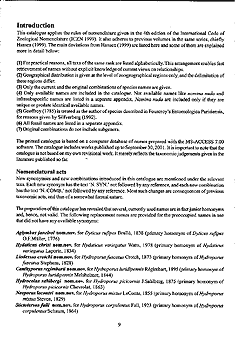
|

|



|
|
At the end of the last year, the Publishing House Apollo Books Aps. (Kirkeby Sand 19, DK-5771, Stenstrup, Denmark - <apollobooks@vip.cybercity.dk>) published the 3rd volume of the world catalogue of insects dedicated to the family Dytiscidae [the previous two authored by M. Hansen) were also dedicated to beetles: the family Hydraenidae forms the first volume (1998) and the superfamily Hydrophiloidea, the 2nd volume (1999)].

|

|

|
This publication and the previous two volumes begin the series that will probably become an important addition to volumes published by W. Junk and S. Schenkling, the major portion of which was published approximately 100 years ago. Unfortunately, unlike W. Junk and S. Schenkling, this series does not provide for references to the entire bibliography, which makes these catalogues less useful. Nevertheless in the last volume A. Nilsson provides important information on each species containing references to publication of the first description with an initial taxonomic interpretation, type locality, designation of syntypes, holotype or lectotype and also references to publication of synonymy on each name and also for species names -- publication of combination accepted in the catalogue with generic and subgeneric names (with appropriate references). All taxonomic references are made in accordance with the last version of the International Code of Zoological Nomenclature (1999). Apart from that the catalogue includes new names for primary and secondary homonyms established by A. Nilsson.
The catalogue covers the entire world fauna of the family, which greatly exceeds the number of species and genera included by Zimmermann,1920 in the catalogue published by Junk and Schenkling: 1887 species belonging to 44 genera. The author uses division of the family into subfamilies and tribes, accepted in one of the last papers by K.B. Miller [Miller K.B. 2001. On the phylogeny of the Dytiscidae (Insecta: Coleoptera) with emphasis on the morphology of the female reproductive system. Insect Systematics & Evolution, 32: 45-92], which includes 10 subfamilies: Agabinae, Colymbetinae, Copelatinae, Coptotominae, Dytiscinae, Hydrodytinae, Hydroporinae, Laccophilinae, Lancetinae и Matinae. Distribution ranges of species are outlined in a general form indicating zoogeographic regions, where a particular taxon (genus, subgenus, or species) penetrates. The broadest interpretation of zoogeographic regions of land is accepted dividing the Earth into the Palearctic, Nearctic, Afrotropical, Oriental, Australian, Neotropical and Pacific Region.

|

|

|
An important difference of the catalogue in question from the Zimmermann's catalogue is inclusion of representatives of the past faunae. This difference is very valuable also for specialists working on modern fauna. Possibly because paleontological forms are seldom used in catalogues on modern faunae and in entomological literature in general, A. Nielsson missed some taxa proposed for extinct water beetles, namely Laccophilus corystes Zhang, 1989 and L. pusulatus Zhang, 1989 (Neogene, China), Procoelambus macrocephalus Theobald, 1937 and Hydroporus trimaculatus Theobald, 1937 (Paleogene, France), and also Dytiscus krausei Kolbe, 1932 and D. latahensis Wickham, 1931 (Neogene). Besides, the author of the catalogue under consideration mentioned species of the genus Palaeodytes Ponomarenko, 1987 as described from the Tertiary deposites, while Palaeodytes gutta Ponomarenko, 1987 is recorded and P. sibiricus Ponomarenko, 1987 - from the Lower Cretaceous of Transbaicalia.
It is very difficult to prepare a large catalogue avoiding misprints, errors and inaccuracies. Therefore the lack of some fossil forms although disappointing in no way diminishes the merits of the catalogue, which deserves a high appraisal, which may to be expected from the coleopterists' community. Apart from the high quality of the text of the catalogue the excellent quality of printing should be also mentioned. The Catalague is printed on high quality paper, bound in good cover; optimum set of different fonts is used. Therefore this book intended for a long use by, probably, several generations of coleopterologists is printed in the form worthy of gaining recognition in the future.
A.G. Kirejtshuk
March 2002